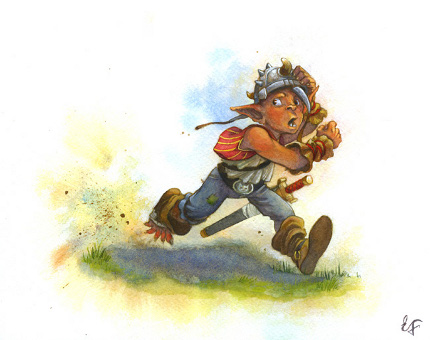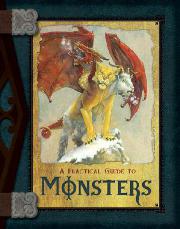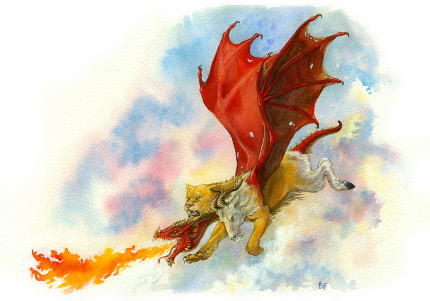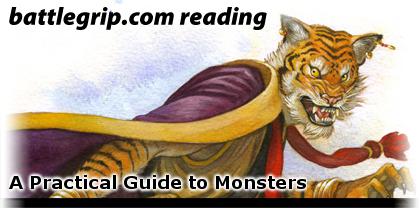Reading – A Practical Guide to Monsters
NOTE: I first posted this online back in 2008. As part of my plan to shift my online content over to battlegrip.com I’m posting the review here. Enjoy! Please keep in mind that all product links to Amazon.com potentially earn cash that I turn around and spend on toys. I like toys.
“The monsters described in this book aren’t the kind that you once feared hid under your bed. No, my friends, these monsters are quite real. They walk our city’s streets in the dead of night. They wait alongside well-traveled paths. Some of them, I dare say, live among us in disguise.â€
– from Zendric’s introduction to the book
Mirrorstone, Wizards of the Coast’s fiction label dedicated to publishing books in the young adults category, is a better introduction to the worlds of Dungeons & Dragons than anything Wizards is releasing that actually has the Dungeons & Dragons logo stamped across its cover. A Practical Guide to Monsters, an 80-page full-color hardcover book, clearly illustrates how this series – if it only possessed the Dungeons & Dragons logo anywhere on it – could be instrumental in leading a new generation to ask “Can I have D&D for my birthday?â€
Let me explain.


The Mirrorstone line includes young adult books set in the Dragonlance and Forgotten Realms worlds but, thus far, each book I’ve seen in the series does not feature the Dungeons & Dragons logo. Fortunately for the brand – and possibly for the future of the hobby – that appears to be changing. The Mirrorstone submission guidelines currently state:
“Mirrorstone will be shifting direction beginning in 2009 to focus exclusively on publishing novels for young readers inspired by the lore of Dungeons & Dragons. We will continue to publish our Practical Guide series as well as other spin-off series such as the Dragon Codex books, and Forgotten Realms related novels like the Stone of Tymora trilogy.â€
Anyway, you’re not reading this for my thoughts about publishing, brands, or introducing young readers to the world of gaming. No, you’re reading this to find out just what, exactly, is within the covers of A Practical Guide to Monsters. (And, possibly, what I think of the book. Short answer? Buy this if you have a child you would like to introduce to the world of Dungeons & Dragons or buy a copy for any kid who loves Harry Potter. This is a great book.)
What? There’s an actual review here?
A Practical Guide to Monsters, presented as a book written by Zendric – self-proclaimed High Wizard and Master of Magic – provides a brief overview of a variety of monsters taken from the Dungeons & Dragons line (some of which, as you know, are adaptations and variants of mythological monsters). The cover, which depicts a chimera, caught my eye at Wal-Mart; this was my introduction to the Mirrorstone line so, hopefully, that means children across the country were also captured by the book’s cover and have discovered the book.
After the cover, while flipping through the book, the first thing that anyone will notice is that Mirrorstone spared no expense in making this a spectacular-looking product. While some of the art is reprinted from existing Dungeons & Dragons releases, most of what’s inside is new – including several illustrations of a young, cute goblin interacting with the environment and some of the monsters that are described. (Cute goblin with Remorhaz. Cute goblin playing a card game. Cute goblin running from Griffon. Cute goblin under the watchful stare of a Beholder. You get the idea.) Every two-page spread of the book is roughly 50% illustrations, so if you’re a fan of monster art you need to take some time to at least flip through this book.

Appearances aside, the book is a delightful read. Zendric – remember, he wrote the book – does an excellent job of presenting the monsters, providing just enough information on each one to give the reader a clear idea of what the monster is and does, while handwritten notes throughout the book expand on Zendric’s writing. (It’s never made clear whether or not the handwritten notes are by Zendric, though I assume that they are.) Many monsters are given only a few paragraphs of description, though each and every one also includes a “Facts†box in which the creature’s vital statistics – Maximum Height, Maximum Weight, Habitat, Society, Diet, Language, Attack Methods, and Best Defense (to use against the monster) – are listed. Some monsters – such as the beholder, medusa, griffon, and a few others – get special treatment, with multiple pages and maps of locations associated with the creature.
The book is divided into a dozen sections, three of which – Monster Protection, Additional Defenses, and Armor – are each a two-page spread showing equipment that you will need to hunt/fight monsters. The other nine sections of the book are:
Creepy Crawlers. The Remorhaz kicks off the book, with three pages devoted to the creature. The descriptive text, as with most of the text, is quite brief, but there’s just enough here to give those unfamiliar with the beast a taste of what it is and what it can do. A typical Remorhaz lair map shows the creature deep beneath the surface, with an unsuspecting caravan making its way past the entrance to the lair. The Thri-kreen, Ankheg, Phase Spider, and Bulette also appear in this section.
Flying Fiends. Opening with the Griffon, this section includes the Chimera (who, as I’ve mentioned, appears on the cover), Manticore (complete with a cute illustration of Manticore young playing), Yrthak, Harpy, and Gargoyle. According to he author, the Harpy never bathes (a common problem with many of the monsters in this book) while the Chimera “almost always launches a surprise attack from the sky.†The half-page artwork for the Griffon’s lair shows a Griffon swooping down to attack horses.
Viperous Villains. Creatures that are snake-like or dealing with snakes dominate this section, starting with four-pages on the Medusa. The opening artwork, with a Medusa and Medusa young (plus the cute goblin hiding behind a shield) stands out (which is saying a lot in a book with so much great artwork) while the fourth page is a page torn from Zendric’s journal (where he tells the tale of visiting a Medusa island). The other monsters in this section are the Yaun-ti, Behir, Ormyrr, Frost Worm, and Purple Worm.
Sneaky Shapeshifters. Can you guess which monster starts this section? Go ahead, try. That’s right, the Werewolf. The opening artwork shows the Werewolf’s stages of transformation (five stages, from human to wolf) while the “lair†illustration is one wagon out of a Werewolf caravan. Other shapeshifters in this section are the Werebear, Wererat, Wereboar, and Doppelganger. Out of the entire book, this section felt like the weakest work. (Though that may just be my personal bias against were creatures.)

Gruesome Goblinoids. Goblins, Hobgoblins, and Bugbears. Here we again encounter creatures that need a bath (“If you ever find yourself in the realm of a goblin lair, you’ll know it by the awful stench.â€) Goblins are the star of this section, with four pages, and the goblin lair map reveals that goblins are beetle farmers and have a meeting room that would make an awesome gaming room. Is it possible that the goblins are gamers?
Mammoth Monsters. This section presents the Troll, and shows their “Trollhole,†and other towering creatures like the Ettin, Giants (Fire, Storm, and Frost), and the Ogre (“Ogres solve problems by smashing them.â€) and Ogre Mage. My personal tastes show through once again (I like giants) when I say that I really enjoyed this section of the book. The “cute goblin running away with baby Griffon†artwork, as always, is cute while a block of box text showing what’s in the typical giant’s bag is mundane but fun.
Unsightly Undead. I think it’s safe to say that Zendric (or, at the very least, Nina Hess, the true author of A Practical Guide to Monsters) loves undead creatures; at ten-pages, this is the longest section of the book. The Vampire is given four pages, two of which are devoted to the “Typical Vampire Lair†which shows three levels of a large house. (Notes in the margins of the page reveal that Vampires like to visit libraries, vampire homes have master suites but the vampires don’t sleep in the bedroom, and that vampires cannot be harmed by poison.) The other monsters in this section are the Ghost, Zombie, Ghoul, Nightwalker, Lich (including a box discussing the Phylactery, of which I have some personal experience and even wrote a PDF, A Dozen Unusual Phylacteries, on the subject), Mummy, Skeleton, and Shadow.
Awful Aberrations. According to Zendric, “Aberrations are quite possibly the strangest monsters in our world. These are the beasts with such bizarre anatomy that they can be classified no other way.†As a Dungeons & Dragons book, it is quite fitting that the Beholder is given the most space in this section of the book. Aaron Allston’s I, Tyrant (an excellent book, even if it’s now two editions out of date) is credited for a small bit of flavor text in the Beholder section. The other aberrations in this section are the Ettercap, Chuul, Otyugh, Rust Monster, Athach, and Grick.
Otherworldly Outsiders. These extraplanar beings close out the book and, unlike the rest of the book, don’t quite feel as if they fit. Again, I suspect this is personal bias (I don’t care for any of the monsters described), but for those of you who are interested I will say that you’ll find the Rakshasa (which could have also fit in the shapeshifter section), Nightmare, Azer, Xorn, and Couatl in this section of the book.
The book closes with a test (the test says that if you answer correctly than you’ll be given your wizard’s robes) that asks questions about the monsters in the book. It’s a cute throw-away page, and something parents could likely use after reading the book with their children.
Final Thoughts
A Practical Guide to Monsters was so much fun to read and flip through that I’ve picked up all four books in the series and the first fiction – Red Dragon Codex – based on one of the books in the series. All of the books in this series are beautiful, packed with artwork that is both fitting for the targeted age group and wonderfully executed; visually, this series is enjoyable by anyone who loves fantasy art.
But these aren’t just picture books and, thankfully, the text is as good as the artwork.
I cannot praise these books enough. While not every gamer will find these books worth owning, every gamer who wants to introduce a child to Dungeons & Dragons should give one of these (any one) as a gift. You may just create a new player with your gift.
